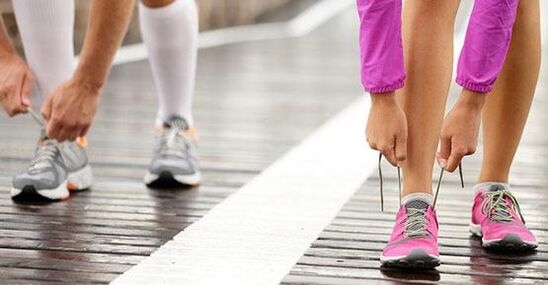
Everyone knows that running can help them lose weight. But hardly anyone is informed that there is real jogging for weight loss. After reading this article, the reasons for the lack of the desired results for many people who have chosen this way of improving their figure will become clear.
The benefits of running
By jogging, you begin to render your body an invaluable service and fill it with health and strength:
- The blood becomes saturated with oxygen;
- The heart and the entire vascular system are strengthened;
- Bones get stronger;
- The lungs increase the vital volume.
When running, breathing and heart rate become more frequent, which speeds up metabolic processes and burns excess fat. But you can only lose weight with it if you do it right.
An important point:Running for 15-20 minutes will not slim your figure, although the healing benefits are evident.
It is recommended to start running two to three times a week and gradually achieve daily training with two days off.
And do not use weight materials, especially for beginners. Such devices are mainly used by athletes to strengthen the leg muscles and increase speed in competition.
So how do you properly run to improve your physical fitness?

Types of jogging for weight loss
To better understand the effectiveness of a particular type of run, you need to understand the mechanism of body work under different loads:
- Light jogging forces the muscles to absorb energy from the sugar (glycogen) stored in the liver. It is usually consumed within 40 minutes of such a charge. After breakfast after exercise, you cannot lose weight because the lost sugar comes back.
- Running for over 1 hour causes the body to break down fat. Outwardly, this is determined by heavy breathing and fatigue.
- If you run for more than 1 hour and 15 minutes, the energy starts to regenerate from proteins, which reduces muscle mass.
- Switching from fast running to light running and walking begins a powerful fat loss process.
At the same time, there is a certain pattern - a person with a larger body mass burns more calories.
It follows that to lose weight, you need to jog for an hour, but no longer than 1 hour 15 minutes, or at intervals.
About interval runs
This type is more suitable for busy people who do not have the opportunity to devote an hour to training. It consists of alternating fast running and recreational walking. With such a load, certain processes are triggered in the body that lead to the burning of fat reserves.
It only takes half an hour for this. The program consists of 4 phases:
- The first 100 meters walk at a brisk pace that helps the body prepare for the exertion.
- Take a gentle run for the next 100 meters and adjust your breathing.
- Then you need to run the same distance at maximum speed.
- And jog again, regain breathing.
Repeat all steps for 30 minutes.
Important:At the end of the workout for the next 6 hours, the human body continues to lose extra pounds.
About easy running (jogging)
A recommendation for beginners is not to run high-speed marathons straight away. The best way to start your workout is to walk slowly, with a gradual transition to running. As you walk, you can do lunges, squats, and jumps. Certain techniques must be followed:
- Breathe in steadily and measuredly, inhaling through your nose and exhaling through your mouth;
- Keep your back straight with a look ahead;
- The knees are slightly bent, which reduces stress on the joints;
- The arms are bent at the elbows and move along the body.
A little piece of advice for women: On "critical days" you shouldn't overexert yourself if you feel unwell. A two-day break can't hurt.

About nutrition
When it comes to nutrition while running, this is also a pretty important issue. The goal is to keep the energy at the right level and prevent the toxic effects of lactic acid with ketone bodies.
Since we consider running as a means of losing weight, it is allowed to eat at least an hour and a half before training.
Before the training
At the same time, you should not rely on cereals and legumes, potatoes and eggplants, mushrooms and cabbage, and spinach with radishes. Do not eat fatty and fried foods.
In order to relieve the kidneys, blood vessels and the heart from overloading, fluid intake must also be restricted. The maximum recommended dose is a glass of water or sweet tea half an hour before jogging. But when running, you need to drink sips - from 2 to 3 every 2 km.
After the race
At the end of the workout, you need to replenish the carbohydrates you have consumed with a glass of tomato, apple, grape or citrus juice.
After about 20-40 minutes (time is individual, but not earlier and not later) you can eat without overeating and not relying on heavy food.
Best time to run
And of course, you can't help but tell the best time to exercise to lose weight. To make the right choice, you need to know:
- In the morning, the human body lacks carbohydrates, as a result of which it absorbs energy for exercise from body fat. In this case, you should walk on an empty stomach.
- Running in the evening helps burn off the energy that has accumulated during the day, which can melt the fat. This is especially true for office workers who are forced to sit at the computer all the time. To lose weight, it is best to run after at least an hour after a light dinner. And before you go to bed, have a drink of low-fat kefir or eat an apple.
As you can see, you can always run to lose weight - the main thing is that it's true.

Who shouldn't jog
It is not recommended to start running for people with health problems such as:
- High blood pressure (hypertension);
- Heart disease and coronary artery disease;
- Deformed vortices;
- Gastric ulcer and varicose veins;
- Myopia;
- Endocrine system diseases and bronchial asthma.
In addition, you can not train on discomfort at the stage of exacerbation and inflammatory processes. Recent surgery or injuries are also contraindications to running.
With all this knowledge, you can safely complete this fascinating type of physical education class. The process becomes even more pleasant when you call a friend or friend about a run.













































































